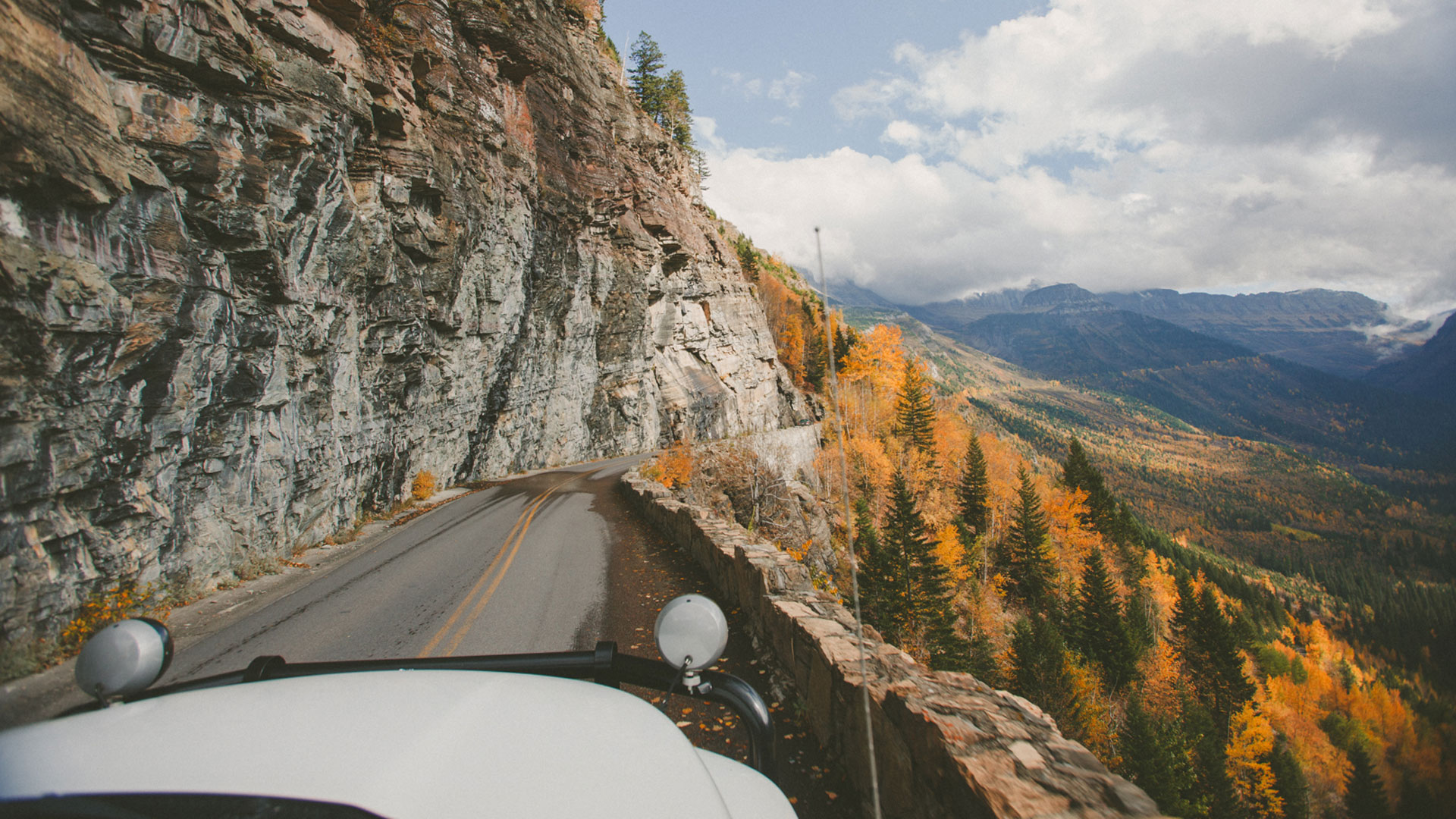

We missed the tourist season but we went anyhow, despite the graying skies and the low sun. Despite the fallen leaves and cold nights. We pointed ourselves north and gunned straight for the Canadian border, toward Glacier National Park. Everyone who’s been uses the same sparkling vocabulary: Gorgeous. Beautiful. Stunning. It’s the kind of consensus that leaves me wary, and when we roll through the gates, I half expect to find Glacier’s thin thread of natural wonder buried under a blanket of humanity. Some version of the Great Smoky Mountains, or another Acadia.
But traffic is sparse heading east on the Going to the Sun Road. Most of the visitor’s centers are closed. The campgrounds reverted to primitive status. The pavement is damp and carpeted in places with aspen leaves. Shocks of yellow against the grays and greens and blacks of the mountains around them. It’s been raining, and the river is full and wide. Waterfalls tumble from the snow line, busy with the work of wearing stone.
Like so many National Parks, this one hides most of its treasures. Keeps them safely snugged away. Staggering vistas and green mountain lakes, all protected by long hikes up into the hills. The pavement will only show you a fraction of what there is to see. The pull-offs for the easy hikes are packed–maybe the only frantic spots in the whole of the place. We idle by them with kiddo asleep in her car seat.

The signs give their warnings. No vehicles over 21 feet. With the beefy ARB bumper and the camper’s dovetail, we’re a foot past that. Maybe more. I decide to take my chances, comfortable in the knowledge that, at it’s heart, the machine is still just a ¾-ton pickup. I have a hard time imaging rangers turning around every long-bed that tries to make the hike.
As the road constricts, it’s not our length that worries me, but our width. Past Crystal Point, the two lane clings to the mountainside, barely wide enough for a pair of compacts to pass. Tourists in packed minivans eye our approach with unease, stopping and letting us take the gamble of passing without contact. The clouds are low as we climb, spitting rain here and there, but they break just long enough to give us a clear view of the wall of stone across the valley. I’ve never seen anything like it. Not in the far north of Norway. Not in the clutches of the Rockies. The ridges are jagged, gouged things. Not carved by the ice that passed over them all those eons ago but scalloped by it, their edges sharp as anything.

We make our way over the pass and into the valley below. It’s getting late by the time we find a campsite at Many Glaciers, and I barely have camp set up before a thunderstorm comes booming its way down the river valley. I’m outside cooking dinner under the awning when the hail hits. Pea-sized ice raining down on the forest, whiting the ground.
The next morning, Beth ushers me out the door. Pushes me to go for a hike while she and Kiddo stay behind for an easy day of naps and movies. A recharge day. I start off for Iceberg Lake. It’s a six-mile walk from the campground, up 1,200 feet to a secluded cirque with a frigid pool at its base. This is bear country. Timid black bears and the more fierce grizzlies roam the forests and alpine meadows. There are signs at the trailhead that say as much. Do not hike alone, they say. I laugh. We all hike alone.

The climb is gradual, wandering from exposed meadow to dense forest and back again. The day is cool, with a perfect blue sky above. The ragged valley stands clear all around, its walls of gray stone so close they look within reach. More waterfalls pour down, crossing the path here and there–bastard, boot-soaking streams, for the most part. Ptarmigan Falls marks the half-way point, the clear water turning to a froth as it tumbles over stones to the canyon below.
It’s past one by the time I finally make it to the wall. The stone bowl is cut in such a way that the sun never fully reaches the floor, at least, not this time of year. There’s still frost on the ground. Snow in the shadows. It feels unnatural and looks like something out of fantasy fiction.

The lake is unreal. Like a figment brought to life. The water is clear at the edge, round gray stones shine through as if sitting beneath plate glass. At its center, the water turns an unnatural blue green. The color of Florida Keys saltwater or mint taffy.
I drop my pack on its shore, put on another layer, and eat a lunch of trail mix and water. There’s no sound past the sparse handful of hikers that come wandering through. They whisper. All of them. The click of their camera shutters louder than their syllables.
It’s mid-afternoon by the time I make it back to the truck. There’s more weather on the way. We’ll make a play for Bowman Lake on the west side of the park. Spend the time cooped up and sheltered against a long, cold rain that will turn to snow a day after we leave. I’ll look at the weather from the damp lowland of Spokane and laugh. Glad that we missed the season. Glad we went anyhow.
